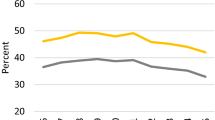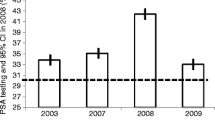Abstract
Objectives: There is a growing epidemiologic literature suggesting an inverse association between history of diabetes and risk of incident prostate cancer. To our knowledge, the relationship between diabetes and tumor features and risk of recurrence among men with prostate cancer has not been examined previously. We hypothesized that men with diabetes would present with more favorable prostate cancer and experience lower risk of recurrence. Methods: We identified 691 men with diabetes at the time of prostate cancer diagnosis, among 6722 men diagnosed with prostate cancer in 1989 to 2002 within CaPSURETM, a community-based prostate cancer registry study. We compared clinical and socio-demographic variables by diabetes status, using χ2 tests, t-tests, and multinomial logistic regression. We examined recurrence rates for prostate cancer among patients with and without diabetes using Kaplan–Meier log-rank tests and Cox proportional hazard models. Results: In multivariate analyses, history of diabetes was not associated with any diagnostic clinical parameter, and treatment-specific recurrence rates for prostate cancer generally did not differ by diabetes history. Among men with low-prognostic risk or who were younger at prostate cancer diagnosis, being diabetic (versus not) was associated with an elevated risk of recurrence after radiation therapy, in multivariate analyses. Conclusions: Contrary to data suggesting that diabetes may be modestly protective against risk of incident prostate cancer, we did not observe any evidence of an inverse association between history of diabetes and aggressiveness at diagnosis or risk of recurrence, in this population of men with prostate cancer.
Similar content being viewed by others
References
K Steenland S Nowlin S Palu (1995) ArticleTitleCancer incidence in the National Health and Nutrition Survey I. Follow-up data: diabetes, cholesterol, pulse and physical activity Cancer Epidemiol Biomarkers Prev 4 IssueID8 807–811 Occurrence Handle8634649
M Mori S Saitoh S Takagi et al. (2000) ArticleTitleA review of cohort studies on the association between history of diabetes mellitus and occurrence of cancer Asian Pac J Cancer Prev 1 IssueID4 269–276 Occurrence Handle12716299
Bonovas S, Filioussi K, Tsantes A (2004) Diabetes mellitus and risk of prostate cancer: a meta-analysis. Diabetologia
AL Coker M Sanderson W Zheng MK Fadden (2004) ArticleTitleDiabetes mellitus and prostate cancer risk among older men: population-based case–control study Br J Cancer 90 IssueID11 2171–2175 Occurrence Handle15150583
K Zhu IM Lee HD Sesso JE Buring RS Levine JM Gaziano (2004) ArticleTitleHistory of diabetes mellitus and risk of prostate cancer in physicians Am J Epidemiol 159 IssueID10 978–982 Occurrence Handle10.1093/aje/kwh139 Occurrence Handle15128610
C Rodriguez AV Patel A Mondul EJ Jacobs MJ Thun EE. Calle (2005) ArticleTitleDiabetes mellitus and risk of prostate cancer in a prospective cohort of US men Am J Epidemiol 161 147–152 Occurrence Handle10.1093/aje/kwh334 Occurrence Handle15632264
E Giovannucci EB Rimm MJ Stampfer GA Colditz WC Willett (1998) ArticleTitleDiabetes mellitus and risk of prostate cancer (United States) Cancer Causes Control 9 IssueID1 3–9 Occurrence Handle10.1023/A:1008822917449 Occurrence Handle9486458
MR Cooperberg JM Broering MS Litwin et al. (2004) ArticleTitleThe contemporary management of prostate cancer in the United States: lessons from the cancer of the prostate strategic urologic research endeavor (CapSURE), a national disease registry J Urol 171 IssueID4 1393–1401 Occurrence Handle10.1097/01.ju.0000107247.81471.06 Occurrence Handle15017184
AV D’Amico R Whittington SB Malkowicz et al. (2002) ArticleTitleBiochemical outcome after radical prostatectomy or external beam␣radiation therapy for patients with clinically localized prostate carcinoma in the prostate specific antigen era Cancer 95 IssueID2 281–286 Occurrence Handle10.1002/cncr.10657 Occurrence Handle12124827
GD Grossfeld DM Latini DP Lubeck et al. (2002) ArticleTitlePredicting disease recurrence in intermediate and high-risk patients undergoing radical prostatectomy using percent positive biopsies: results from CaPSURE Urology 59 IssueID4 560–565 Occurrence Handle10.1016/S0090-4295(01)01658-2 Occurrence Handle11927314
JW Moul (2003) ArticleTitleVariables in predicting survival based on treating ‘PSA-only’ relapse Urol Oncol 21 IssueID4 292–304 Occurrence Handle12954500
Consensus statement: guidelines for PSA following radiation therapy (1997) American Society for Therapeutic Radiology and Oncology Consensus Panel. Int J Radiat Oncol Biol Phys 37(5): 1035–1041
PH Gann CH Hennekens J Ma C Longcope MJ. Stampfer (1996) ArticleTitleProspective study of sex hormone levels and risk of prostate cancer J Natl Cancer Inst 88 IssueID16 1118–1126 Occurrence Handle8757191
JM Chan MJ Stampfer J Ma et al. (2002) ArticleTitleInsulin-like growth factor-I (IGF-I) and IGF binding protein-3 as predictors of advanced-stage prostate cancer J Natl Cancer Inst 94 IssueID14 1099–1106 Occurrence Handle12122101
AW Hsing GW Comstock (1993) ArticleTitleSerological precursors of cancer: serum hormones and risk of subsequent prostate cancer Cancer Epidemiol Biomarkers Prev 2 27–32 Occurrence Handle8420607
W Demark-Wahnefried SM Lesko MR Conaway et al. (1997) ArticleTitleSerum androgens: associations with prostate cancer risk and hair patterning J Androl 18 IssueID5 495–500 Occurrence Handle9349747
AM Nomura GN Stemmermann PH Chyou BE Henderson FZ Stanczyk (1996) ArticleTitleSerum androgens and prostate cancer Cancer Epidemiol Biomarkers Prev 5 IssueID8 621–625 Occurrence Handle8824364
HA Guess GD Friedman MC Sadler et al. (1997) ArticleTitleFive α-reductase activity and prostate cancer: a case–control study using stored sera Cancer Epidemiol Biomarkers Prev 6 IssueID1 21–24 Occurrence Handle8993793
E Barrett-Connor C Garland JB McPhillips K Khaw DL Wingard (1990) ArticleTitleA prospective, population-based study of androstenedione, estrogens, and prostate cancer Cancer Res 50 169–173 Occurrence Handle2293551
LJ Vatten G Ursin RK Ross et al. (1997) ArticleTitleAndrogens in serum and the risk of prostate cancer: a nested case–control study from the Janus serum bank in Norway Cancer Epidemiol Biomarkers Prev 6 IssueID11 967–969 Occurrence Handle9367072
JF Dorgan D Albanes J Virtamo et al. (1998) ArticleTitleRelationships of serum androgens and estrogens to prostate cancer risk: results from a prospective study in Finland Cancer Epidemiol Biomarkers Prev 7 IssueID12 1069–1074 Occurrence Handle9865423
R Heikkila K Aho M Heliovaara et al. (1999) ArticleTitleSerum testosterone and sex hormone-binding globulin concentrations and the risk of prostate carcinoma: a longitudinal study Cancer 86 IssueID2 312–5 Occurrence Handle10.1002/(SICI)1097-0142(19990715)86:2<312::AID-CNCR15>3.0.CO;2-7 Occurrence Handle10421267
P Stattin S Lumme L Tenkanen et al. (2004) ArticleTitleHigh levels of circulating testosterone are not associated with increased prostate cancer risk: a pooled prospective study Int J Cancer 108 IssueID3 418–424 Occurrence Handle10.1002/ijc.11572 Occurrence Handle14648709
C Chen NS Weiss FZ Stanczyk et al. (2003) ArticleTitleEndogenous sex hormones and prostate cancer risk: a case–control study nested within the carotene and retinol efficacy trial Cancer Epidemiol Biomarkers Prev 12 IssueID12 1410–1416 Occurrence Handle14693730
JC Massengill L Sun JW Moul et al. (2003) ArticleTitlePretreatment total testosterone level predicts pathological stage in patients with localized prostate cancer treated with radical prostatectomy J Urol 169 IssueID5 1670–1675 Occurrence Handle10.1097/01.ju.0000062674.43964.d0 Occurrence Handle12686805
TA Stamey M Caldwell JE McNeal R Nolley M Hemenez J Downs (2004) ArticleTitleThe prostate specific antigen era in the United States is over for prostate cancer: what happened in the last 20 years? J Urol 172 IssueID4 Pt 1 1297–1301 Occurrence Handle10.1097/01.ju.0000139993.51181.5d Occurrence Handle15371827
Author information
Authors and Affiliations
Corresponding author
Rights and permissions
About this article
Cite this article
Chan, J., Latini, D., Cowan, J. et al. History of Diabetes, Clinical Features of Prostate Cancer, and Prostate Cancer Recurrence-Data from CaPSURETM (United States). Cancer Causes Control 16, 789–797 (2005). https://doi.org/10.1007/s10552-005-3301-z
Received:
Accepted:
Issue Date:
DOI: https://doi.org/10.1007/s10552-005-3301-z




